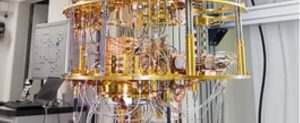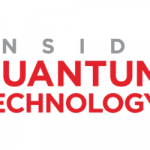Quantum News Briefs April 17: Qunnect Unveils R&D Facility and GothamQ Network Research Hub at Brooklyn Navy Yard; EY and IBM expand strategic alliance into quantum computing; Investor Place: Three promising quantum computing stocks to buy in April; Cornell researchers bring quantum error correction closer to reality + MORE

Quantum News Briefs April 17: Qunnect Unveils R&D Facility and GothamQ Network Research Hub at Brooklyn Navy Yard, EY and IBM expand strategic alliance into quantum computing; Investor Place: Three promising quantum computing stocks to buy in April; Cornell researchers bring quantum error correction closer to reality + MORE.
Qunnect Unveils R&D Facility and GothamQ Network Research Hub at Brooklyn Navy Yard
NOTE: IQT had a great time at Qunnect’s lab opening at Brooklyn Navy Yard Friday for World Quantum Day. Thanks to Qunnect for having us! Sharing their formal news announcement below.
Qunnect, an industry leader in quantum-secure networking technology, announceed the expansion of its facilities in the Brooklyn Navy Yard April 14. The newly constructed 4000 sqft R&D facility and a 1500 sq. ft. Network Research Hub for the GothamQ Network will support Qunnect’s networking technology, designed for scalable deployment on existing telecom fiber infrastructure.
“GothamQ is the first network of its kind in the US dedicated to the practical distribution of useful  entanglement to perform quantum networking protocols over metropolitan distances,” notes Qunnect CEO Noel Goddard. “This network will not only host new forms of secure communication, but it will also support other quantum devices, including computers and sensors. This collection of capabilities will serve as the foundation for the Quantum Internet.”
entanglement to perform quantum networking protocols over metropolitan distances,” notes Qunnect CEO Noel Goddard. “This network will not only host new forms of secure communication, but it will also support other quantum devices, including computers and sensors. This collection of capabilities will serve as the foundation for the Quantum Internet.”
On the occasion of Quantum Day, Qunnect is also very proud to announce the commercial launch of its QU-SOURCE product. QU-SOURCE is the only entanglement source on the market that produces exceptionally pure polarization photon pairs that are readily compatible with telecom fiber and atomic-based quantum devices. A manuscript describing the underlying physics can be viewed here on ArXiv (link)
Qunnect’s QU-SOURCEs are installed on the GothamQ network where the company is performing pilots on 34km loops traversing Brooklyn and Queens. These products are supported by another recently launched product, the QU-APC, (link to OFC press release), which corrects for damaging fluctuations in the fiber channels caused by environmental perturbations.
Qunnect’s QU-SOURCEs are installed on the GothamQ network where the company is performing pilots on 34km loops traversing Brooklyn and Queens. These products are supported by another recently launched product, the QU-APC, (link to OFC press release), which corrects for damaging fluctuations in the fiber channels caused by environmental perturbations.
“We are introducing a source capable of generating more than ten million pairs of high fidelity polarization entangled photons with sub-GHz linewidth, high heralding efficiency and bichromatic wavelength to be compatible with telecom fibers and atomic devices,” explains Co-Founder and CSO Mehdi Namazi. “Additionally, by leveraging GothamQ, we proved the practicality of distributing these entangled photons over 34km of New York City deployed fibers, while maintaining high rate, high entanglement fidelity, and very high, uninterrupted network uptime.”
Click here to read news release in-entirety describing the opening of Qunnect’s R&D Facility.
EY and IBM expand strategic alliance into quantum computing
 The EY organization and IBM have announced that EY Global Services Limited will be joining the IBM Quantum Network, further enabling EY teams to explore solutions with IBM that could help resolve some of today’s most complex business challenges. The EY organization will gain access to IBM’s fleet of quantum computers over the cloud, and will become part of the IBM Quantum Network’s community of organizations working to advance quantum computing.
The EY organization and IBM have announced that EY Global Services Limited will be joining the IBM Quantum Network, further enabling EY teams to explore solutions with IBM that could help resolve some of today’s most complex business challenges. The EY organization will gain access to IBM’s fleet of quantum computers over the cloud, and will become part of the IBM Quantum Network’s community of organizations working to advance quantum computing.
The EY organization established its own Global Quantum Lab last year with a mission to harness quantum value in the domains of trust, transformation and sustainability. Using IBM quantum technology, EY teams plan to conduct leading-class practice research to uncover transformative use cases, including: the reduction of CO2 emissions from classical computing, the improvement of safety and accuracy of self-driving cars, and most critically, integrate quantum benefits into organizations’ mainstream systems for data processing and enterprise decision making.
Membership in the IBM Quantum Network is part of a broader effort by the EY organization to invest and develop robust capabilities in emerging technologies, which already include artificial intelligence, blockchain, and metaverse development. Beyond the increased investment of the EY-IBM Alliance, the EY organization is investing $10 billion in technology initiatives over three years, including investment in the organization’s own quantum function.
Andy Baldwin, EY Global Managing Partner – Client Service, said”Quantum, in terms of importance to business, society and the EY organization, is akin to what AI represented years ago. This alliance puts the EY organization at the forefront of technology. As we invest in this level of quantum computing access, we accelerate our own position and depth of knowledge and capabilities in this space and deepen the rich relationship with our IBM alliance teams.”
Jeff Wong, EY Global Chief Innovation Officer, said: “As we navigate this period of technology-led change, which is accelerating at unprecedented speed, companies must have a full understanding of how to maximize breakthrough innovations in order to keep pace. Through this collaboration with IBM, the EY organization will now have the ability to take advantage of quantum computing to propel its innovation journey.” Click here for complete news announcement.
Investor Place: Three promising quantum computing stocks to buy in April
 Muslim Farooque, who is billed as a “keen investor and an optimist at heart”, is the author of an April 13 InvestorPlace article citing three quantum computing stocks with “tremendous upside ahead”, with a sector he reports is poised for a staggering 37% annualized growth rate through 2030. Quantum News Briefs summarizes below.
Muslim Farooque, who is billed as a “keen investor and an optimist at heart”, is the author of an April 13 InvestorPlace article citing three quantum computing stocks with “tremendous upside ahead”, with a sector he reports is poised for a staggering 37% annualized growth rate through 2030. Quantum News Briefs summarizes below.
IBM (NYSE:IBM) is one of the top quantum computing plays, which boasts an incredible line-up of products in the sector. It boasts over 20 of the most powerful quantum computing systems, with its most recent 433 qubits release. Though quantum computing represents just a small part of IBM’s business, IBM stock could move independently in line with the expansion in the quantum computing space.
IonQ (NYSE:IONQ) is arguably the best pure-play in the quantum computing space. The firm is developing trapped-ion quantum computers that can be used effectively for general use and has partnerships having a profound impact on its financials. Furthermore, it has a robust balance sheet with $355 million in cash and short-term investments. With this stockpile, the company can effectively weather the economic volatility for the foreseeable future and continue pushing toward long-term expansion.
As the quantum computing revolution gains momentum, semiconductor giant Taiwan Semiconductor (NYSE:TSM) has made impressive strides to stay ahead of the curve. Semiconductors are critical components in quantum computing, facilitating the creation of advanced processors. With TSMC’s leading position in the chip sphere, it has the potential to become a major player in the quantum computing space.
Furthermore, in its unique collaboration with Taiwan’s Ministry of Science and Technology, the firm has unveiled a state-of-the-art cloud computing platform that effectively unlocks the potential of quantum algorithms for businesses. Click here to read original article in-entirety.
Cornell researchers bring quantum error correction closer to reality
 Cornell researchers have recently taken a step toward fault-tolerant quantum computing: they constructed a simple model containing exotic particles called non-Abelian anyons, compact and practical enough to run on modern quantum hardware. Realizing these particles, which can only exist in two dimensions, is a move towards implementing it in the real world.
Cornell researchers have recently taken a step toward fault-tolerant quantum computing: they constructed a simple model containing exotic particles called non-Abelian anyons, compact and practical enough to run on modern quantum hardware. Realizing these particles, which can only exist in two dimensions, is a move towards implementing it in the real world.
Thanks to some creative thinking, Yuri Lensky, a former Bethe/Wilkins/Kavli Institute at Cornell (KIC) postdoctoral fellow in physics in the College of Arts and Sciences (A&S), collaborating with Eun-Ah Kim, professor of physics (A&S), came up with a simple “recipe” that could be used for robustly computing with non-Abelian anyons, including specific instructions for executing the effect experimentally on devices available today.
Their paper, “Graph Gauge Theory of Mobile Non-Abelian Anyons in a Qubit Stabilizer Code,” written in collaboration with theorists at Google Quantum AI, published March 24 in Annals of Physics. Google Quantum AI researchers, together with Lensky and Kim, have proved the theory with a successful experiment as reported in a preprint publication, “Observation of Non-Abelian Exchange Statistics on a Superconducting Processor,” on the research-sharing platform arXiv.
“This two-dimensional state is interesting both from a quantum condensed matter physics perspective – it has some novel properties that are very special to 2D physics – and from a quantum information perspective,” Lensky said. “It’s something truly quantum, but it’s also potentially useful for quantum computation. It protects bits of quantum information by storing them non-locally, and our protocol allows us to compute with these bits.”
Kim explained the principle that animates non-Abelian anyons by holding out two identical one-pound barbells. When she crosses her arms, the identical barbells change positions, but as objects defined by classical physics, their state remains the same. They are interchangeable. Click here for complete article by Kate Blackwood at Cornell.
Will quantum computing replace cloud computing?
 A new trend is emerging, with cloud-based quantum computing combining both technologies and their advantages and providing direct access to quantum computers via the web using the cloud. Emi Lacapra of CoinTelegraph is the author of a recent extensive discussion of cloud-based vs cloud-based quantum computing. Quantum News Briefs summarizes below.
A new trend is emerging, with cloud-based quantum computing combining both technologies and their advantages and providing direct access to quantum computers via the web using the cloud. Emi Lacapra of CoinTelegraph is the author of a recent extensive discussion of cloud-based vs cloud-based quantum computing. Quantum News Briefs summarizes below.
While quantum computing will not replace the cloud anytime soon, Big Tech companies are working on integrating the two solutions to get the most out of both worlds. Such integration can facilitate remote access to quantum computers using the cloud and be available to a broader range of users.
Cloud-based quantum computers can accelerate the pace of tech innovation, streamlining the work of researchers and developers who could access quantum hardware and computational resources via the cloud, leading to breakthroughs and discoveries faster.
Businesses and individuals must overcome numerous challenges before being ready to integrate quantum and cloud computing. For instance, the complexity of accessing quantum computers and the expertise required to handle them make it challenging for the average person to use quantum solutions in the cloud. Another concern is security, as sensitive quantum algorithms must be safeguarded from unauthorized access or tampering, which is more prevalent in the cloud. Click here to read article in-entirety.
Sandra K. Helsel, Ph.D. has been researching and reporting on frontier technologies since 1990. She has her Ph.D. from the University of Arizona.




















